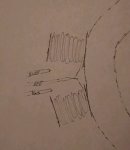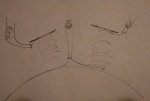Pusher
Lieutenant
- Joined
- Sep 2, 2014
- Messages
- 1,273
Well, I am rather stumped. I couldn't get enough of the hard plastic coating off to get a good idea of what is going on. The yellow wires continued to be brittle the full length into the case (as well as corroded). You have to love how a manufacturer will make something that could last a hundred years, then add a wire that will make it 30. The red, blue, and black wires are still pliable and valid. The yellow ones are just trash.
There's a yellow wire going off in each direction.
The red and blue wires look to be going to the same way which is what's confusing me a bit.
The black ground looks to be going to the round thing in the lower right of the stator. (That would be the ground coming up and soldering to the stator wrap wire before I removed the solder joint.)
The magnet wire itself looks like it is the size of 6lb monofilament fishing line. VERY tiny.... Why so small?
I am hoping to have a plan of action for tomorrow and either repair this sucker (if possible at this point) or start re-wrapping it.Honestly, I am half tempted to stick the whole thing in a fire and cook the plastic off. If I did that, then I'd order magnet wire and the wells solder tool tomorrow.
Help/advice is appreciated.
Seems odd. The red/blue leads dive off to the right outside of both coils 11 & 12. Is that so they could be taped to the coil for support before going back to 11 & 12 for soldering?
























